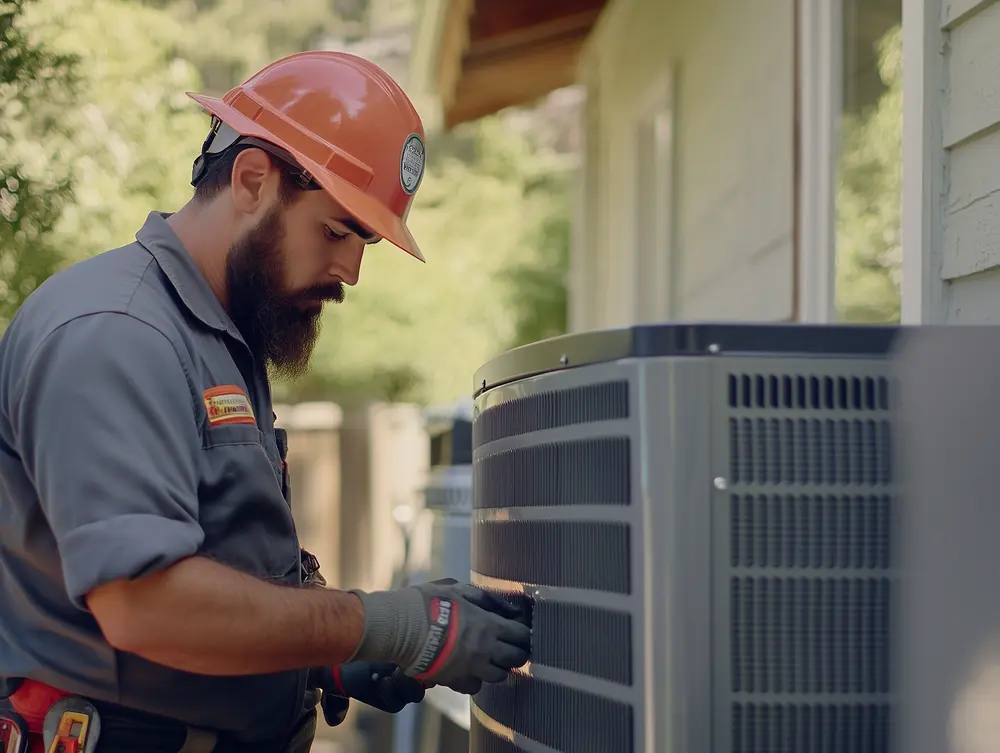The call comes in at 2:30 PM on the hottest day of the year: “The AC isn’t working in unit 304, and it’s over 110 degrees inside.” Fifteen minutes later, another call, this time from unit 217. By 4:00 PM, your maintenance team is juggling five emergency AC repair requests, your on-call HVAC contractor is booked until tomorrow, and your property manager is fielding angry calls from residents.
Sound familiar? For multifamily and rental property managers, summer AC emergencies represent one of the most challenging aspects of property operations. Not only do these issues strain maintenance resources, but they also impact resident satisfaction and your bottom line through unnecessary vendor costs.
However, forward-thinking property managers are transforming their approach to summer AC emergencies through remote visual diagnostics and repair. By seeing problems before dispatching technicians, these properties are dramatically improving their emergency response while protecting their NOI and enhancing resident satisfaction.
The True Cost of Summer Emergency AC Repair
The direct costs for calling out an HVAC vendor for a rush job in the heat of summer can be significantly higher than for a routine service. According to HomeGuide, after-hours emergency HVAC repair calls usually run about double or triple the standard rate due to overtime costs and difficulty sourcing parts.
But the financial impact of air conditioning emergencies extends beyond the visible repair costs.
The indirect costs of resident churn: The National Apartment Association reports that maintenance directly impacts renewal decisions, with residents citing apartment condition and maintenance staff as reasons for leaving a rental.
The hidden costs of staff departure: Maintenance staff burnout during high-volume periods leads to increased turnover in an already tight labor market. The Employment Policy Foundation finds that the average cost to replace an employee in the trade/transportation industry estimated at $11,820.
At the heart of these costs is what we call the “triage gap”—the critical lack of context that prevents maintenance teams from properly assessing AC emergencies. Without visual information, maintenance coordinators must make guesses based on limited resident descriptions, often resulting in misclassified emergencies and unnecessary truck rolls.
Why Traditional AC Emergency Response Falls Short
Traditional approaches to handling AC emergencies are increasingly inadequate in today’s fast-paced property management environment:
Problem #1: Lack of context leads to misclassification
When residents report an AC issue, they often lack the technical vocabulary to accurately describe the problem. Is it truly not cooling, or is it a thermostat setting issue? Without visual context, it’s nearly impossible to tell.
Problem #2: Limited visibility forces unnecessary truck rolls
Without 3D diagnostic capabilities that include visual and audio in real-time, it’s very difficult for technicans to fix problems remotely. For property managers, this translates to thousands of dollars in unnecessary vendor visits.
Problem #3: Prioritization challenges during high-volume periods
During heat waves, maintenance teams struggle to determine which AC issues are genuine emergencies versus those that can wait. Without visual confirmation, everything becomes “urgent.”
Problem #4: Lack of responsiveness increases frustration
Because AC breakdowns are so uncomfortable and even dangerous during hot weather, residents are likely even more sensitive to delays or miscommunication. And unhappy residents are less likely to renew.
Consider this common scenario: A resident reports their AC “isn’t working at all.” A technician is dispatched, only to discover the issue is a simple thermostat battery replacement—a five-minute fix that cost a full service call and delayed response to other emergencies.
The Remote AC Diagnostics Advantage for Emergencies
Remote visual diagnostics fundamentally transforms emergency AC repair response in two critical areas: triage and truck roll reduction.
Triage Transformation
The ability to see a problem rather than just hear about it completely changes how maintenance teams handle emergency AC repair calls:
- Accurate assessment: Maintenance coordinators can visually confirm whether a unit is truly not cooling or if the issue is simpler, such as improper thermostat settings.
- Real-time troubleshooting: Simple diagnostic steps can be guided remotely, such as checking supply vents for airflow or inspecting the condition of air filters.
- Proper classification: True emergencies (no cooling during extreme heat) can be separated from important but non-emergency issues (reduced cooling efficiency).
Fixing triage has a multiplier effect, making every subsequent step downstream more efficient and impactful.
Truck Roll Reduction
Not all AC emergencies require an immediate on-site visit. Remote diagnostics help identify which issues truly need in-person response:
Common AC issues that could be diagnosed or even fixed remotely include:
- Thermostat programming/battery issues: Sometimes the AC unit is fine, but the thermostat is faulty or misconfigured, so it doesn’t signal cooling correctly. Temperature sensors in the unit can also become faulty.
- Tripped breakers/GFCI outlets: In peak hot weather, AC units have to work harder to keep the desired temperature, which leads to increased electrical consumption and greater likelihood of tripping a breaker or GFCI.
- Dirty filters restricting airflow: A clogged filter means less efficient cooling. Checking for a dirty AC filter is generally quite easy and can be done visually by a resident.
- Condensate line clogs: These can often be identified by checking the drain pan and examining the drain line opening or trying to flush the line with water.
Implementing remote diagnostic capabilities reduces unnecessary truck rolls. For property managers, this translates directly to protected NOI and more efficient resource allocation.
First-Time Fix Rate: The Power of Remote AC Diagnosis
When on-site visits are truly necessary, remote diagnostics dramatically improves first-time fix rates by ensuring technicians arrive prepared.
Consider this scenario. An apartment community is experiencing frequent callbacks for AC repairs, with technicians often needing to make multiple visits for parts. After implementing remote visual diagnosis, technicians can visually inspect issues before arriving, bring the right parts, and increase their first-time fix rate.
For example, during a remote diagnostic session, a maintenance coordinator might observe that a condenser fan motor isn’t spinning while the compressor runs. With this specific information, the technician can bring the exact replacement part needed, complete the repair in a single visit, and move on to the next emergency more quickly.
Implementing an Emergency AC Response Strategy with Remote Diagnostics
Here’s how to implement an effective emergency AC response strategy using remote diagnostics:
Step 1: Establish clear emergency criteria
Define what constitutes a true AC emergency (e.g., no cooling during extreme heat for vulnerable residents) versus urgent but non-emergency issues. Make these criteria visible to both staff and residents.
Step 2: Create a visual triage process
Implement a remote visual diagnostic step for all incoming AC requests, using a guided video session between residents and maintenance staff.
Step 3: Develop a remote resolution toolkit
Create step-by-step policies for resolving common AC issues remotely, including visual references and troubleshooting steps that residents can perform with guidance.
Step 4: Train maintenance staff on remote diagnostic procedures
Ensure your team knows how to effectively guide residents through visual inspections and basic troubleshooting steps.
Step 5: Implement resident communication templates
Develop scripts and communication templates specifically for remote AC troubleshooting that acknowledge residents’ discomfort while guiding them through the diagnostic process.
Maximizing Maintenance Efficiency During Peak Season
Remote diagnostics allows for better resource allocation during the high-volume summer season:
- Focused internal technicians: Keep your skilled maintenance staff working on genuine technical issues rather than simple fixes.
- Better vendor management: When contractors are needed, provide them with specific diagnostic information that improves first-time fix rates.
- Prioritized workload: Create clear categories for AC issues based on severity, resident vulnerability, and complexity of the required fix.
- Self-service options: For tech-savvy residents, provide guided self-service options for simple fixes like filter replacements or thermostat resets.
The Resident Experience Transformation
Perhaps the most significant benefit of remote diagnostics is the improved resident experience:
- Faster initial response: Using remote diagnostic and repair capabilities will reduce initial response times.
- Transparency in communication: Visual communication builds trust by showing residents exactly what’s happening rather than relying on technical explanations.
- Educational opportunities: Remote diagnostic sessions provide natural opportunities to educate residents on proper HVAC use and simple maintenance.
- Reduced in-unit traffic: Many residents prefer remote resolution that doesn’t require maintenance personnel to enter their home.
As summer temperatures continue to rise, so do resident expectations for prompt, effective AC emergency repair response. Remote diagnostic capabilities address the twin challenges of triage and truck rolls by providing the visual context needed for better decision-making while reducing unnecessary site visits.
Properties implementing remote diagnostic capabilities gain a significant competitive advantage through improved resident satisfaction, protected NOI, and more efficient maintenance operations during the challenging summer season.
Don’t let this summer’s AC emergencies drain your resources and resident goodwill. The implementation of remote diagnostic capabilities can transform your emergency response strategy, ensuring your maintenance team is prepared to handle whatever the season brings.




